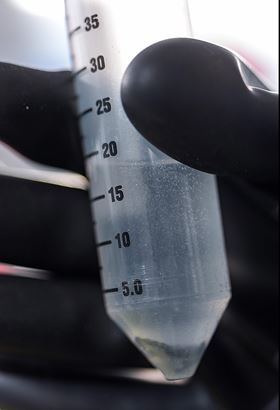 Researchers have developed a new low-cost technique for converting bulk powders directly to oxide nanowires. Shown is a crucible in which an alloy of Li and Al is being formed. (Credit: Rob Felt, Georgia Tech.)
Researchers have developed a new low-cost technique for converting bulk powders directly to oxide nanowires. Shown is a crucible in which an alloy of Li and Al is being formed. (Credit: Rob Felt, Georgia Tech.) In the next step of forming oxide nanowires, bulk powders are dissolved in ethanol. (Credit: Rob Felt, Georgia Tech.)
In the next step of forming oxide nanowires, bulk powders are dissolved in ethanol. (Credit: Rob Felt, Georgia Tech.) Colored electron microscopy image of an alumina (Al2O3) nanowire membrane. The image size (approximately 30 micron x 20 micron) is about three-times smaller than a diameter of a human hair (around 100 micron).
Colored electron microscopy image of an alumina (Al2O3) nanowire membrane. The image size (approximately 30 micron x 20 micron) is about three-times smaller than a diameter of a human hair (around 100 micron).Researchers from Georgia Institute of Technology have devised a simple and straightforward way of transforming bulk metal alloys directly into nanowires [Lei et al., Science 355 (2017) 267].
Nanowires and other one-dimensional materials such as nanowhiskers, nanofibers, and nanotubes have the potential to boost the electrical, optical, thermal, and mechanical properties of a wide range of materials and composites. But the production of one-dimensional materials can be expensive and difficult, requiring catalysts, sacrificial templates, or specialized equipment.
Now, Gleb Yushin, professor of Materials Science and Engineering at Georgia Institute of Technology and co-Editor-in-Chief of Materials Today, has hit on a much simpler solution that works at room temperature and pressure. The fundamentally new synthesis mechanism exploits strain energy minimization at the boundary of a chemical transformation reaction front, explains Yushin.
In reality, what this means is that if a bimetallic alloy (such as Li-Al or Li-Mg) is immersed in a solvent (such as alcohol), the more reactive component (Li) dissolves while the other less reactive element (Al or Mg) forms a forest of nanowires on the surface of the bulk particles. Ultimately, the entire alloy particle is transformed into nanowires. A simple heat treatment of the as-formed nanowires turns them into metal oxide nanowires.
Moreover, the length, morphology, and diameter of the nanowires can be fine-tuned by controlling the size of the alloy particles, the solvent used, and the temperature of the reaction, respectively.
“The bulk nanowire synthesis process does not involve exfoliation, does not require catalysts, does not use toxic or corrosive chemicals, and does not employ any external stimuli,” points out Yushin.
The researchers believe that the process is driven by interfacial stresses, which create nanosized cracks in the alloy surface. This network of cracks forms nanosized islands, which act as nuclei for growing nanowires.
“The mechanism is universal and should allow for a broad range of chemistries to be explored,” Yushin says. “We aim to report a broad range of other materials, including various other ceramic nanowires.”
The possibilities for the process are almost endless. But the team demonstrated one potential application, creating flexible alumina ‘paper’ for Li-ion battery separators. The ceramic nanowire paper membrane offers the flexibility of conventional polymer options but can withstand much higher temperatures and is highly permeable to the electrolyte, enabling faster transport of Li ions and faster charging rates.
“This discovery may reduce the synthesis cost of nanofibers by orders of magnitude,” suggests Yushin, enabling applications as catalyst supports, sensors, flexible electronics, membranes, and lightweight ultra-strong composites.